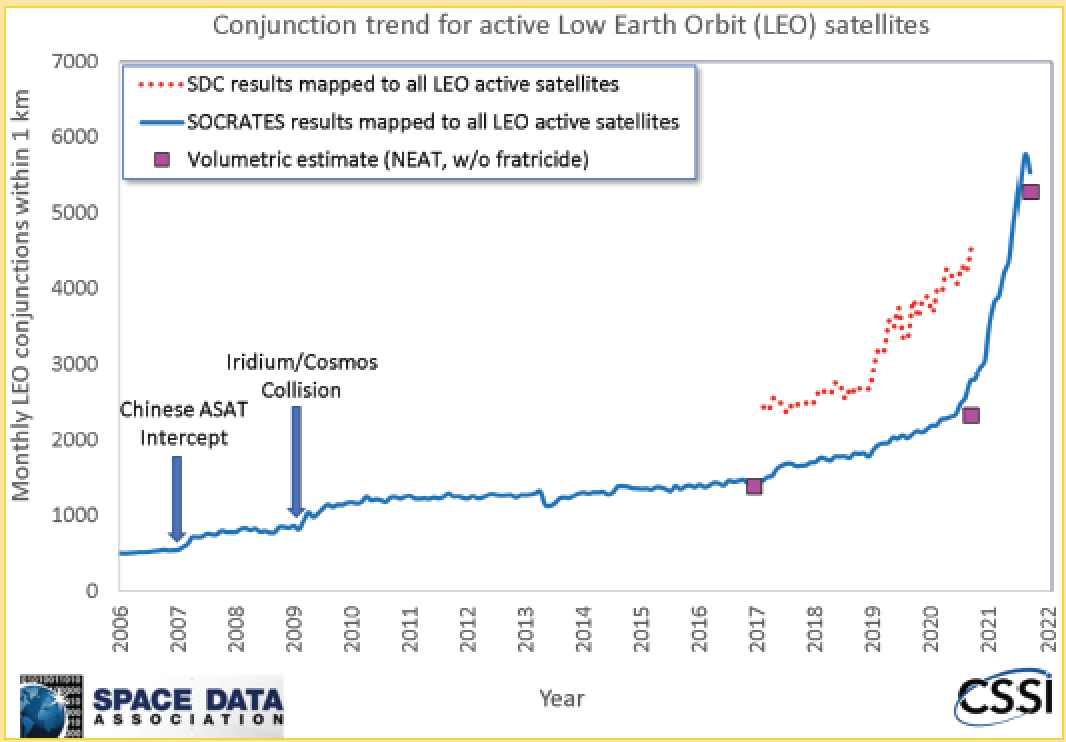Today’s new space environment brings with it the promise of growth, sustainability, and new opportunities for future generations; however, with these unprecedented opportunities comes significant challenges in securing this expanding space frontier.

Today’s space operations environment is growing significantly, with over 7,500 active satellites in Low Earth Orbit (LEO) and an average increase of three, active, satellites added daily. This number will continue to increase as new space actors and organizations build, launch, and operate still more low-cost platforms for space exploration, communications, Earth Observations (EO), and data-gathering tasks. Risky interactions between these largely commercial satellites are on the rise1.
Meanwhile, rogue operators2 and the ever-increasing space debris population3 create a hazardous environment that further jeopardizes safe space operations. Suitable solutions to monitor, analyze, and alert operators are available, though many operators continue to rely on ineffective, outdated legacy systems that are not sufficiently accurate, timely, and comprehensive to determine if or when space objects are coming too close. Unfortunately, such ineffective flight safety services lead to a false sense of safety, unrealized and unmitigated risks, and false alarms that place undue burdens on spacecraft operators and waste avoidance maneuver fuel and valuable resources.
Newer, commercial space situational awareness SSA technologies can drastically improve space safety. But even these technological advances are not sufficient; it is also of utmost importance to establish and adhere to industry norms to help maintain a safe space environment.
Earlier this year, an international coalition of industry and government satellite operators, launch vehicle and spacecraft manufacturers, SSA companies, and other space stakeholders, announced updates to its landmark set of best practice guidelines and expected norms of behavior, establishing a new set of “rules of the road” space operations coordination.
This ad hoc group, the Space Safety Coalition (SSC), published its “Best Practices for the Sustainability of Space Operations” (SSC Best Practices) to address emerging safety and sustainability concerns, providing a model framework for topics that are critical for space safety.
Founded in 2019, the SSC was established to evolve, maintain, and promote a set of best practices for safe space operations. The Coalition’s new guidelines both incorporate and then extend beyond recently updated non-binding guidelines and standards from key international governing bodies including the United Nations, the Inter-Agency Debris Coordination Committee (IADC), the International Organization for Standardization (ISO), and the global space agency-led Consultative Committee for Space Data Systems (CCSDS).

The SSC’s “living framework” improves guidance for launch vehicle selection, spacecraft disposal upon mission completion, cybersecurity, spacecraft anomaly root cause assessment, and prevention of intentional collision or fragmentation events. These voluntary best practices include over 40 additional specific guidance points to increase safety in all orbital regimes including:
• Exchange of specific information relevant to safety-of-flight and collision avoidance
• Selection of launch vehicles with due consideration for space sustainability
• Responsible mission and constellation design to prioritize space safety
• Spacecraft designs that facilitate disposal reliability of up to 95% success rate
• Minimization of casualty risk
• Mitigation of post-mission fragmentation risk
• Designs that facilitate sensor trackability
• Designs that facilitate spacecraft servicing and active removal
• Active avoidance of collisions
• Passivation of spacecraft upon end of mission or after collision avoidance phase
• Disposal within 5 years of end-of-mission for maneuvering spacecraft
• Maintenance of accurate spacecraft positional knowledge
Today, 36 representatives from the commercial space community have endorsed the updated guidelines including manufacturers, launch providers, spacecraft operators, consultants, foundations, mission extension, active debris removal service providers, commercial, SSA companies and insurers. As space traffic increases, safeguards are necessary to ensure safety and sustainability — as space becomes progressively central to critical infrastructures humanity depends upon, it is increasingly vital to secure the safety, reliability, and robustness of space assets. Global cooperation, shared best practices, and established industry norms spanning all phases of the spacecraft life cycle must keep pace with this growing activity.

References


1 Oltrogge, D.L., Alfano, S., Wilson, J. and Wauthier, P., “Evaluation of LEO conjunction rates using historical flight safety systems and analytical algorithms,” IAC-21-A6.7x65213, 72nd International Astronautical Congress (IAC), Dubai, United Arab Emirates, 25-29 October 2021, COMSPOC Technical Paper #224, freely available for download at www.comspoc.com/research/technical-library.
2 Oltrogge, D.L., Alfano, S., and Hall, R., “Comparison of predicted and observed spacecraft encounters from Russian ASAT test,” AMOS 2022 Conference, Maui HI USA, 28 Sep 2022, COMSPOC Technical Paper #324, freely available for download at www.comspoc.com/research/technical-library.
3 Video, “Evolution in rate of LEO close approaches with major fragmentation events,” freely available at www.comspoc.com/ research/technical-videos.
Author Dan Oltrogge is the founder and administrator of the Space Safety Coalition and Chief Scientist of COMSPOC.


